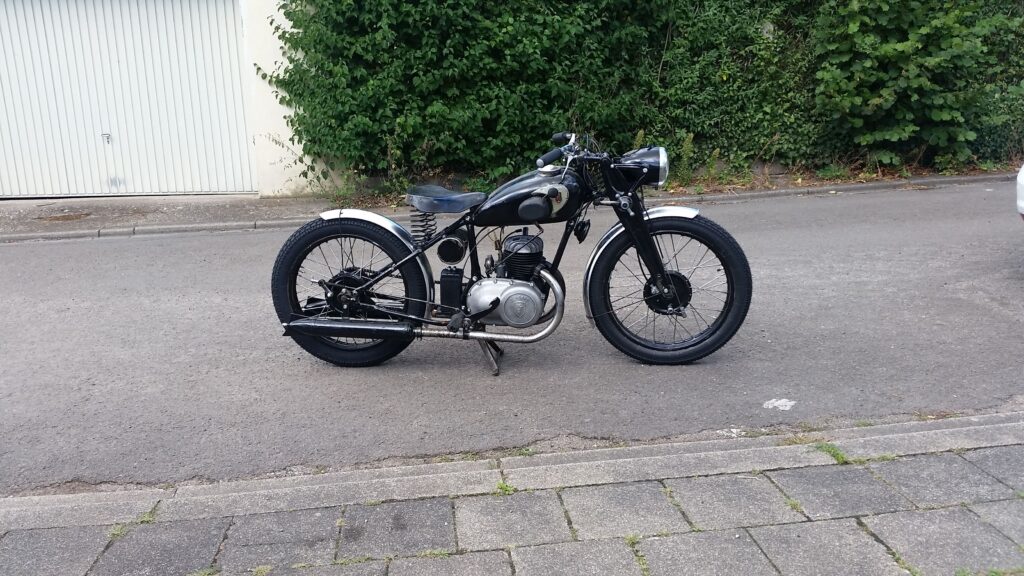
General Information:
Introduced in 1935 (source: wikipedia) was a easy to buy vehicle produced by Zündapp in Nürnberg. It perfectly fitted (and was probably designed for) a rule of the time in germany which made it possible to drive motorcycles with up to 200cc without owning a specific drivers license. After WW2 it was one of the first „pre war designs“ with which Zündapp relaunched production. This one in particular carries most of the pre war settings, since later Zündapp attached telescopic forks and even with rear plunger suspension. Since I am a girder fork disciple, I am very happy I got one of the earlier years.
It is a 200cc double port two-stroke engine, with a tank-shifted 3 speed gearbox, and a rigid rear frame. The frame one these models is no coherent element, but is bolted together out of various moduls. Thus it is considered rather squishy but up to the engines performance. This particular bike was in moderate condition when the restauration started. The engine hadn’t run in more then a decade but it was mostly complete and undamaged disregarding one or two minor spills.
With this one, similar to the NSU Quickly mentioned in another article on this website, I decided to keep most of its patinated paint and only clean the frame to coat it with transparent paint.
The engine here underwent (already finished at this point) a complete overhaul with new shaft seals and bearings. Luckily even the engine was in rather good condition, so I reused all major parts like the gears, cylinder and piston.
The restauration itself:

-preliminary planning:
Here I started over with the engine. The plan is, to reassemble the vehicle around the overhauled engine and get the job done piece by piece. By doing so, I have the satisfaction of seeing the thing grow and actually seeing the „got a bit of work done today“ process every time I get the chance to work on that project.
Afterwards, as mentioned above, I plan to clean and overhaul the frame and the fork and coat it with transparent paint, as well as all the other attachements like the horn and the speedometer.
Good thing about that is, that it keeps the budget rather low, compared to a „full on“ chassis restauration and makes it easier to overlook small flaws.
-procedure:

Image 3 
Image 4 
Image 5
First step of the work was the diassembling of the engine. Luckily with the correct tools, this was rather easily done, since it is not a very complex engine. Although a post WWII product, most of the sealings are still sealed via felt rings. Only one crankshaft end was „already“ sealed with a more modern rubber shaft sealing. A very interesting feature, that makes the felt sealings work properly are labyrinth-seal-structures in the gearbox-casing, that keep the gearoil form leaking out. Solutions like can barely be found on more modern designes, since almost everything has been switched to rubber sealing. The rather large downside of this solution is, that the sharp sealing-lips of the rubber-rings continously damage the surface of the shafts. Which is not a problem in the first thrity years of an machines existence can became quite annoying if someone starts restoring such a design. (…to be continued)

I got it up and running:
After adding more and more pieces to the puzzle, (the upper description still lacks a major part of the story) I finally got the bike to run. Having just a very simple wiring yet (Just to see if it fires up properly) it fired away very quickly. A bummer was, that the kickstarter shaft was not „positioned“ correctly, which leads to the kickstarter mechanism not moving out of its engangement with the gearshafts. You can hear a ratteling while it runs. After the here shown test run I pulled the engine and set the kickstarter shaft into the right position. This fact is probably the most tricky about the engine: The „driving dog“ that pulls the gearbox into one direction to fire up the engine (and slips afterwards, works like an overrunning pulley) has 5+ possible positions and works in all of them. It just does not disengage afterwards. And there are no markings.
Not it is up and running (and starting) properly!
Stepping away from „the original“
When I came to the point that I had the chassis and engine completed and set up to be able to drive, the next step was to get it ready to pass the federal inspection to again get an official license plate and registration. Apart from equipping it with a new O-Ring chain (its not the stock-standard but state of the art and lasts way longer) and getting the lights to work, it went a bit sideways. I new that I needed a front fender
